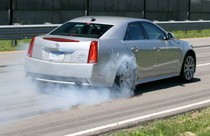
click above for a new high-res gallery of the 2009 Cadillac CTS-V
This week the Cadillac communications crew invited a group of media out to General Motors' Milford Proving Ground for a special preview of the new second-generation Cadillac CTS-V. We first saw the CTS-V last January at the Detroit Auto Show and more information has been dribbling in the intervening time period. A few weeks back, GM's resident speed demon engineer John Heinricy took a production spec CTS-V to an all-time lap record of 7:59.32 for a production sedan at the Nürburgring, and this week Cadillac revealed the official SAE certified power numbers for the super-Caddie at 556 horsepower and 551 pound-feet of torque.
When we got to Milford our handlers took us out to a tent by the Lutz-ring test track where we found three CTS-Vs and various displays of the hardware contained within. Heinricy was on hand as well to tell the tale of the "fast lap" last month. For those who may not have been paying sufficient attention over the past 6 months, the CTS-V is GM's answer to all those German uber-sedans like the Mercedes E63 AMG, Audi RS4 and RS6 and, of course, the one that started the madness, the BMW M5. Read on after the jump to learn more about what makes this Caddie so special and what it was like to go for a ride.
BONUS: Four videos after the jump, including burn-out runs from both inside and outside the new 2009 Cadillac CTS-V.
Photos Copyright ©2008 Sam Abuelsamid / Weblogs, Inc.
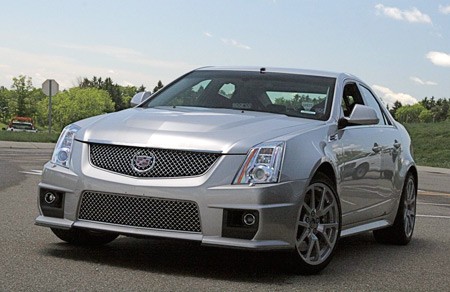
You read that right, we rode in it. Cadillac wasn't quite ready to let us climb behind the wheel, but we did get to ride shotgun with some of GM's top engineers. One of the three cars on hand for this event, the silver one, was the same car that John Heinricy drove to a 7:59.32 lap at the Nurburgring last month. All three cars had the same production level hardware. The only difference with the silver car was fire safety equipment, a pair of racing seats and a brace to which were attached the required five-point safety harness. Cadillac took three CTS-Vs to Germany for a final round of validation testing on the 'Ring, as well as the autobahn. As the clock was running down on the team's track rental, there was only time for one full hot lap. Since they didn't have time to go all the way around the 12-mile circuit to cross the start/finish line at speed, Heinricy went back three corners to make a running start and then blistered the track as time ran out.
The video meant to be presented here is no longer available. Sorry for the inconvenience.
John Heinricy explains his 7:59:38 'Ring time in the CTS-V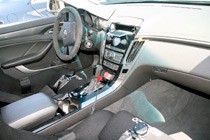
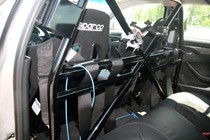
We wrote in detail about the CTS-V's powerplant back in January, but this is the first opportunity we've had to experience the beast up close. With the supercharged 6.2L LSA V8 now officially outputting 556 hp and 551lb-ft of torque, perhaps the single biggest problem is putting it to use. Turning all that power into kinetic energy can easily cause all manner of mayhem at the drive wheels (rear, of course). Since roads are rarely as uniform as we would like, and the vertical forces acting on the tires are almost never equal, one drive wheel usually looses traction before the other. Once that happens, the drive torque gets sent over to the other wheel via the traction control systems and limited slip differentials.
When the engine produces a lot of torque, the half-shafts twist like a spring and then release when the tire looses traction. If the half-shafts are identical in size, the release on one side can cause the other side to wind up and then reverse the process. Exciting the system in this way ultimately causes the wheels to start bouncing around in a phenomenon known as axle hop. When the wheels start hopping, the car doesn't accelerate and, if you're trying to accelerate out of a corner, you can easily get totally out of control.
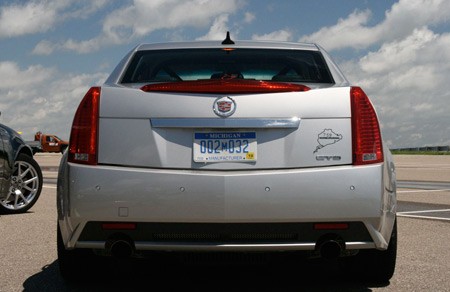
Most manufacturers try all kinds of fancy suspension geometries and control schemes to get axle hop under control. The GM suspension engineers decided to go back and look at the root cause of the problem and discovered that it was triggered by the half-shafts alternately winding up and releasing. After analyzing the problem, they discovered that by changing the effective spring rate of the axle shafts they could virtually eliminate axle hop by ensuring the oscillation frequency of each side was different, thus eliminating the excitation that was occurring.
The video meant to be presented here is no longer available. Sorry for the inconvenience.
Cadillac CTS-V suspension setup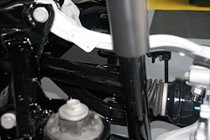
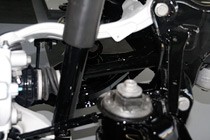
They did this by making the left half-shaft (above, left) almost twice the diameter of the one on the right (above, right). The result is that even with all that torque, the CTS-V has some of the cleanest, smoothest launches with no skittering or bouncing around. The system works so well that GM has applied for a patent on the design and the Corvette ZR1 uses the same setup.
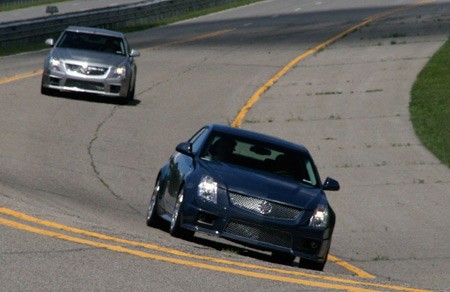
The other main mechanical difference in the suspension is the second generation Magne-Ride system. The basic principal remains the same, but the implementation has been refined. The hydraulic fluid within the dampers is impregnated with iron particles. When electro-magnets in the dampers are energized, the viscosity of the fluid is continuously varied to get just the right damping rate. For the new version, the shape of the pistons has been revised allowing for a greater dynamic of control. The controls engineers have also played an important part in upgrading Magne-Ride. The software now features more feed-forward control that looks at the inertial sensors (yaw-rate, lateral acceleration, longitudinal acceleration) and the driver inputs (steering angle, throttle and brake) and anticipates the direction that the car is going to adjust the dampers preemptively. If the driver turns the wheel to the right while hitting the brakes, the left front damper will tighten up before the weight transfer even occurs.
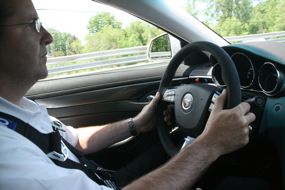
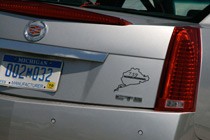
All of this stuff works amazingly well on the track. On the north-south straightaway at Milford, Lead Engineer for Performance Integration Chris Berube gave me a ride in the silver car that Heinricy used to set the 'Ring record. Regardless of whether Chris simply moved his right foot from the brake to the gas or used both feet to induce a smoky burnout, the back end of the Cadillac stayed planted and pointed in the right direction. There was no sign of any bouncing either from inside the car or watching from outside. The only feeling was pure, unabated acceleration. The record car was equipped with the 6L90 automatic transmission and even this high-powered monster had incredibly fast and smooth shifts. In fact, the shifts were so smooth and perfectly matched to the engine speed that the car felt more like an electric drive than an internal combustion beast.
The video meant to be presented here is no longer available. Sorry for the inconvenience.
2009 Cadillac CTS-V burnouts during testing at GM's Milford proving groundsAccording to Berube, the automatic and manual are about equally quick, although the manual car was slightly behind the record car at the ring because Heinricy wasn't at the wheel. When driving the automatic, Berube likes to use the steering wheel shift buttons when drag racing, but when cornering hard he puts the shifter in sport mode and lets the transmission decide when to shift. The shift schedule is programmed for optimum performance when pushing the car hard, including blipping the throttle on down-shifts. How fast can the CTS-V accelerate? From a standstill, 60 mph is an easy 3.9-second jaunt on the way to 118 mph at the quarter-mile mark. If you have the room to keep your foot in it, the automatic will hit redline in 6th at about 175 mph while the three-pedal version can top 191 mph. GM has no plans to artificially restrict those top speeds, either.
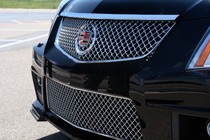
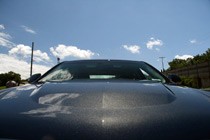
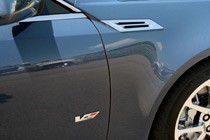
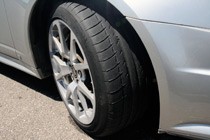
After frying lots of rubber on the straight-away, I hopped in a car with Chassis Integration Engineer Chuck Tomlinson for a couple of laps around the ride and handling loop. We did a lap each of the track with the Magne-Ride in Sport and Touring mode. The Milford ride and handling loop has a mix of different road textures including smooth and rough pavement and simulated rail-road crossings. For a car with the performance capabilities of the CTS-V, it rides remarkably well even cornering hard on rough pavement. It just goes to show that having a fundamentally good base makes it easier to deliver an amazing everyday supercar.
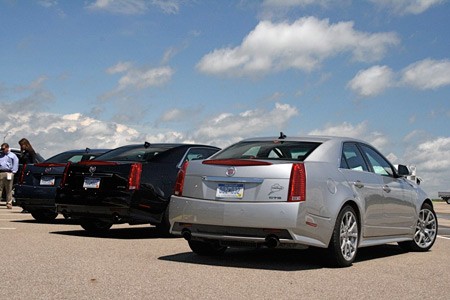
Likely the only view that M5 drivers will have of the CTS-V
GM isn't announcing pricing yet, but indications are that the Cadillac CTS-V will be somewhere around $70,000. If this car pans out to be as good as it seemed today, the engineers in Stuttgart, Munich and Ingolstadt are going to have their work cut out for them. We can't wait for our own opportunity to get behind the wheel later this summer.
The video meant to be presented here is no longer available. Sorry for the inconvenience.
Inside the 2009 Cadillac CTS-V doing burnoutsPhotos Copyright ©2008 Sam Abuelsamid / Weblogs, Inc.

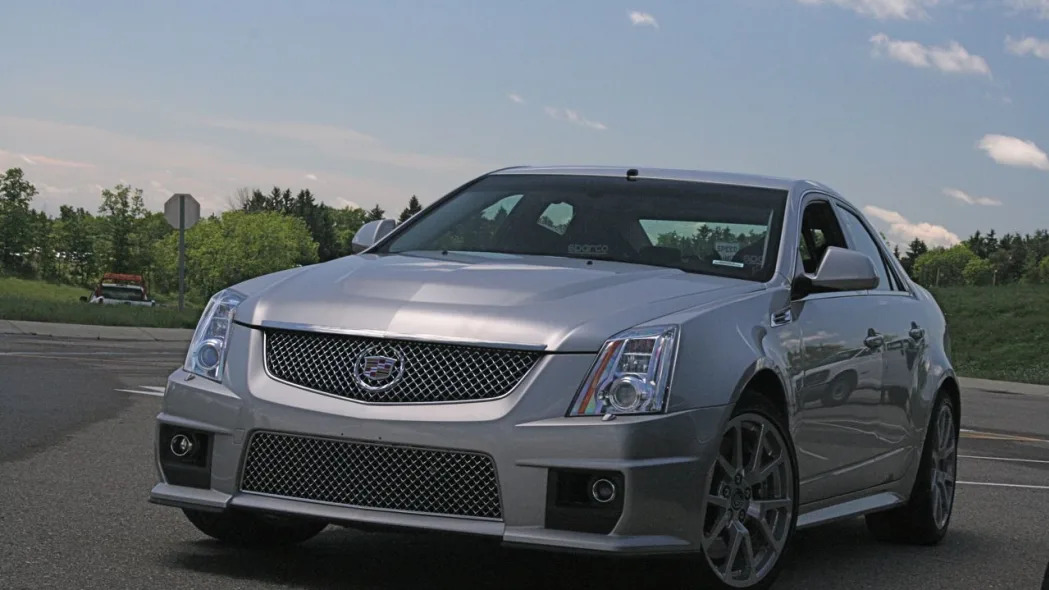

Sign in to post
Please sign in to leave a comment.
Continue